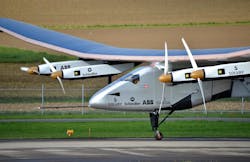The solar-powered airplane, Solar Impluse 2, that is being flow on a voyage around the world, had to postpone its last stop in the United States before crossing the Atlantic ocean due to weather conditions.
On Monday, the Swiss-made carbon-fiber aircraft was scheduled to take off from the Lehigh Valley International Airport in Allentown, Pennsylvania, to New York City. Once in New York City, the plane was supposed to fly over the Statue of Liberty and land at John F. Kennedy International Airport, and from there head to Europe or Northern Africa. However, showers and thunderstorms in the area caused the delay in departure.
"We try not to go over the limits," pilot Andre Borschberg said in a solarimpluse.com video. "That's what we did not do, and for this I am extremely happy. But disappointed of course that we can not proceed."
The journey around the world, piloted by Borschberg and Bertrand Piccard, began March 2015 from Abu Dhabi, the capital of the United Arab Emirates.
Solar Impluse 2, which has a mission to promote clean energy, conservation and continual flight with solar power, has been in Allentown since May 25, after arriving on delay from Dayton, Ohio due to damage to the plane's mobile hangar.
"This is a once-in-a-lifetime opportunity for our region and community to be a part of aviation history," Charles Everett, executive director of the Lehigh-Northampton Airport Authority told The Morning Call. "We have constructed a temporary hangar and continue to work with the Solar Impulse team to fulfill the needs of their mission."
The plane, which weighs about 5,100 pounds and has wings equipped with 17,000 solar cells that store power, is on a long, but slow moving voyage. The typical speed of the flight is 28 miles per hour.
Although the journey hasn't faced many other delays, it's had its set-backs. Most notably during the plane's longest leg, a five-day trip from Japan to Hawaii. The trip took a toll on the aircraft, with damage to the battery system which lead to a nine month lay over in Hawaii. From there, the voyage resumed with a three-day trip from to California.
About the Author
Vesna Brajkovic
Vesna Brajkovic, who grew up around pilots and aviation mechanics, creates digital content for AviationPros.com. She recently graduated from the University of Wisconsin-Whitewater. When she's not writing about the aviation industry, you can find her freelancing for MyCommunityNow-Lake Country (USA Today Network). She can be reached at [email protected].
